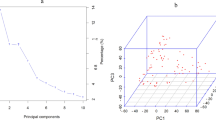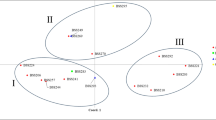Abstract
RAPD band reproducibility and scoring error were evaluated for RAPDs generated by 50 RAPD primers among ten snap bean (Phaseolus vulgaris L.) genotypes. Genetic distances based on different sets of RAPD bands were compared to evaluate the impact of scoring error, reproducibility, and differences in relative amplification strength on the reproducibility of RAPD based genetic distance estimates. The measured RAPD data scoring error was 2%. Reproducibility, expressed as the percentage of RAPD bands scored that are also scored in replicate data, was 76%. The results indicate that the probability of a scored RAPD band being scored in replicate data is strongly dependent on the uniformity of amplification conditions between experiments, as well as the relative amplification strength of the RAPD band. Significant improvement in the reproducibility of scored bands and some reduction in scoring error was achieved by reducing differences in reaction conditions between replicates. Observed primer variability for the reproducibility of scored RAPDs may also facilitate the selection of primers, resulting in dramatic improvements in the reproducibility of RAPD data used in germplasm studies. Variance of genetic distances across replicates due to sampling error was found to be more than six times greater than that due to scoring error for a set of 192 RAPD bands. Genetic distance matrices computed from the RAPD bands scored in replicated data and RAPD bands that failed to be scored in replicated data were not significantly different. Differences in the ethidium bromide staining intensity of RAPD bands were not associated with significant differences in resulting genetic distance matrices. The assumption of sampling error as the only source of error was sufficient to account for the observed variation in genetic distance estimates across independent sets of RAPD bands.
Similar content being viewed by others
References
Aruna M, Ozias-Akins P, Austin ME, Kochert G (1993) Genetic relatedness among rabbiteye blueberry (Vaccinium ashei) cultivars determined by DNA amplification using single primers of arbitrary sequence. Genome 36:971–977
Beebe SE, Ochoa I, Skroch PW, Nienhuis J, Tivang J (1995) Genetic diversity among common-bean breeding lines developed for Central America. Crop Sci 35:1173–1178
dos Santos JB, Nienhuis J, Skroch P, Tivang J, Slocum MK (1994) Comparison of RAPD and RFLP genetic markers in determining genetic similarity among Brassica oleracea L. genotypes. Theor Appl Genet 87:909–915
Edgington ES (1980) Randomization tests. Marcel Dekker, Inc., New York
Ellsworth DL, Rittenhouse KD, Honeycutt RL (1993) Artifactual variation in randomly amplified polymorphic DNA banding patterns. Biotechniques 14:214–217
Gower JC (1972) Measures of taxonomic distances and their analysis. In: Weiner JS, Huizinga J (eds) The assessment of population affinities in man. Clarendon Press, Oxford, pp 1–24
Heun M, Helentjaris T (1993) Inheritance of RAPDs in F1 hybrids of corn. Theor Appl Genet 85:961–968
Heun M, Murphy JP, Phillips TD (1994) A comparison of RAPD and isozyme analyses for determining the genetic relationships among Avena sterilis L. accessions. Theor Appl Genet 87: 689–696
Huang LM, Jeang KT (1994) Long-range jumping of incompletely extended polymerase chain reaction fragments generates unexpected products. Biotechniques 16:242–246
Hunt GJ, Page RE (1992) Patterns of inheritance with RAPD molecular markers reveal novel types of polymorphism in the honey bee. Theor Appl Genet 85:15–20
Kresovich S, Williams JGK, McFerson JR, Routman EJ, Schaal BA (1992) Characterization of genetic identities and relationships of Brassica oleracea L.via a random amplified polymorphic DNA assay. Theor Appl Genet 85:190–196
Lamboy (1994a) Computing genetic similarity coefficients from RAPD data: the effects of PCR artifacts. PCR Methods Applic 4:31–37
Lamboy (1994b) Computing genetic similarity coefficients from RAPD data: correcting for the effects of PCR artifacts caused by variation in experimental conditions. PCR Methods Applic 4:38–43
Nienhuis J, Tivang J, Skroch PW, dos Santos JB (1995) Genetic relationships among cultivars and landraces of lima bean (Phaseolus lunatus L.) as measured by RAPD markers. J Am Soc Hort Sci 120:300–306
Novy RC, Kobak C, Goffreda J, Vorsa N (1994) RAPDs identify varietal misclassifcation and regional divergence in cranberry [Vaccinium macrocarpon (Ait.) Pursh]. Theor Appl Genet 88:1004–1010
Skroch PW, Nienhuis J (1995) Qualitative and quantitative characterization of RAPD variation among snap-bean (Phaseolus vulgaris) genotypes. Theor Appl Genet 91:1078–1085
Skroch PW, dos Santos JB, Nienhuis J (1992a) Genetic relationships among Phaseolus vulgaris genotypes based on RAPD marker data. Annu Rep Bean Improv Coop 35:23–24
Skroch PW, Tivang J, Nienhuis J (1992b) Analysis of genetic relationships using RAPD marker data. In: Applications of RAPD technology to plant breeding. Crop Science Society of America, Madison, Wisconsin
Steel RGD, Torrie JH (1980) Principles and procedures of statistics: a biometrical approach. McGraw-Hill Publishing Company,
Stiles JI, Lemme C, Sondur S, Morshidi MB, Manshardt R (1993) Using randomly amplified polymorphic DNA for evaluating genetic relationships among papaya cultivars. Theor Appl Genet 85:697–701
Vierling RA, Nguyen HT (1992) Use of RAPD markers to determine the genetic diversity of diploid, wheat genotypes. Theor Appl Genet 84:835–838
Weeden NA, Timmerman GM, Hemmat M, Kneen BE, Lofhi MA (1992) Inheritance and reliability of RAPD markers. In: Applications of RAPD markers to plant breeding. Crop Science Society of America
Welsh J, McClelland M (1990) Fingerprinting genomes using PCR with arbitrary primers. Nucleic Acids Res 18:7213–7218
Williams JGK, Kubelik AR, Livak KJ, Rafalski JA, Tingey SV (1990) DNA polymorphisms amplified by arbitrary primers are useful as genetic markers. Nucleic Acids Res 18:6531–6535
Yang X, Quiros C (1993) Identification and classification of celery cultivars with RAPD markers. Theor Appl Genet 86:205–212
Author information
Authors and Affiliations
Additional information
Communicated by G. E. Hart
Rights and permissions
About this article
Cite this article
Skroch, P., Nienhuis, J. Impact of scoring error and reproducibility RAPD data on RAPD based estimates of genetic distance. Theoret. Appl. Genetics 91, 1086–1091 (1995). https://doi.org/10.1007/BF00223923
Received:
Accepted:
Issue Date:
DOI: https://doi.org/10.1007/BF00223923




